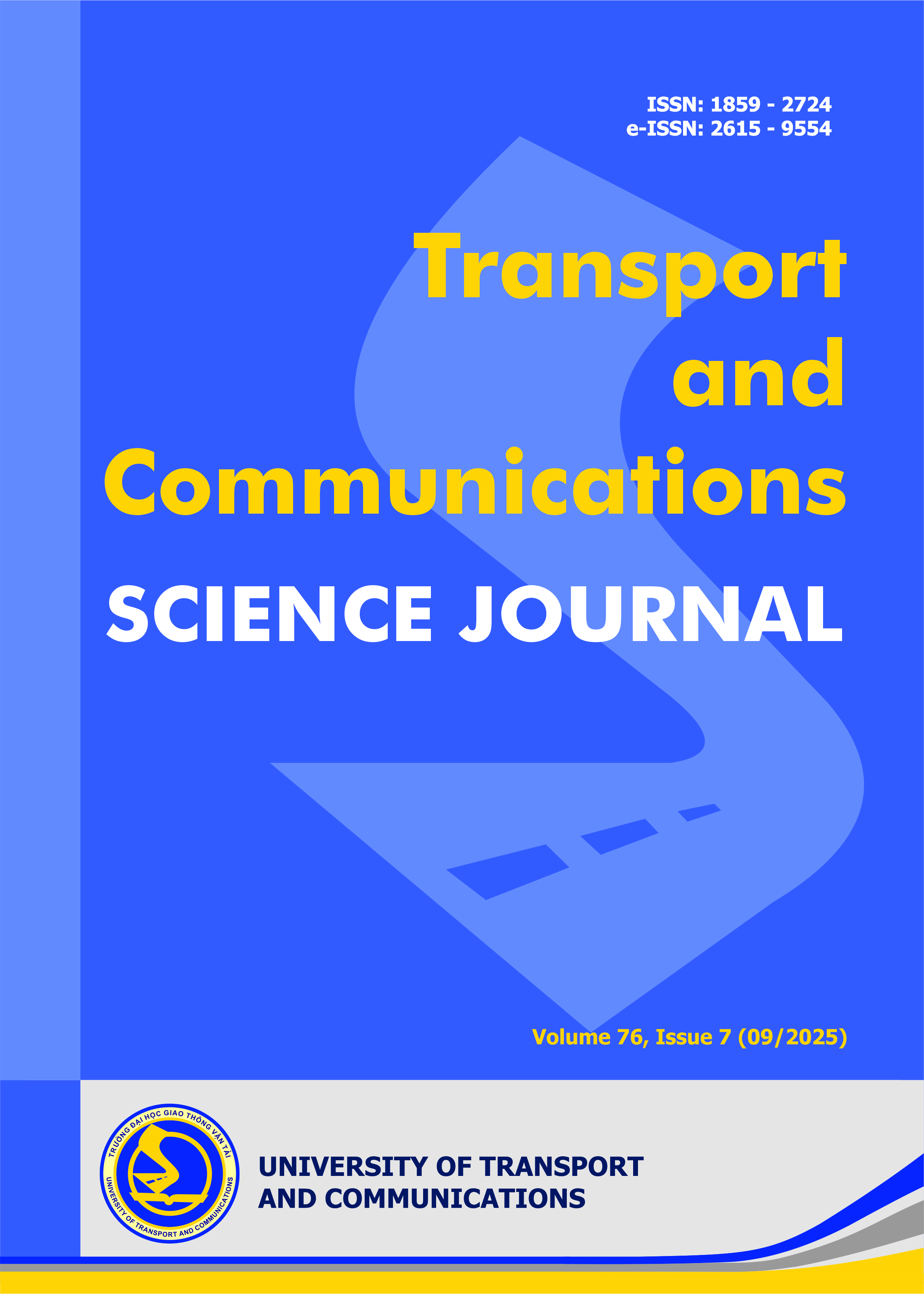Study of static bending of functionally graded beams using analytical method
Trang: 928-938 Nguyen Chi Tho, Vu Van Hoang, Le Hong Hai, Nguyen Huu Ha, Pham Duc Thao, Dao Minh TienTóm tắtBeams made from variable mechanical properties materials are increasingly used in the fields of construction and transportation. The article presents a study on the static bending response of functionally graded composite beams resting on a two-parameter elastic foundation based on an exact solution. The material of the plate varies exponentially with the thickness variation. The calculations are formulated based on Timoshenko's first-order shear deformation theory, and the equilibrium equations of the beam are derived using the principle of virtual work. An analytical method is employed to derive expressions for displacement and rotation at any point along the beam. The reliability of the study is validated by comparison with previously published solutions. Furthermore, this study also investigates the effects of material, geometric, and elastic foundation parameters on the displacement and rotation responses of the composite beam. This research serves as a significant foundation for engineers in designing and manufacturing practical structures
Trang: 939-950 Dam Vu Son Quyen, Nguyen Dinh Quang, Tran The HungTóm tắtReducing drag on boattail configurations remains a critical challenge in external aerodynamics. In this work, numerical simulations were conducted to examine the influence of longitudinal groove depth – represented by the groove-peak distance parameter A – on the flow behavior and drag characteristics of axisymmetric boattail bodies. The parameter A was varied between 0 and 0.3 times the body diameter (D). The computations employed the Reynolds-Averaged Navier–Stokes (RANS) equation for the similation. The k-ω SST turbulence model at a freestream velocity of 22 m/s. Results indicate that groove depth has negligible effect on drag at a 14° boattail angle, but at 18° a substantial reduction in drag of up to 11% was obtained for A = 0.3D. Analysis of pressure distribution, skin friction, and wake structure confirms that deeper grooves help suppress flow separation on the boattail surface. These findings highlight the importance of groove depth selection for optimizing aerodynamic efficiency in axisymmetric vehicles
Design optimization for material reduction in motorcycle brake discs
Trang: 951-964 Ngo Anh Vu, Vu Duy Duc, Tran Manh Quan, Vu Quoc Huy, Bui Van HungTóm tắtBrake discs are essential components in motorcycle braking systems, where structural strength and thermal stability significantly affect vehicle safety and performance. However, conventional brake disc designs often encounter trade-offs between weight reduction and mechanical durability. This study aims to analyze and optimize the design of a motorcycle brake disc to reduce weight and stress while maintaining structural integrity and performance. A standard disc model from the HONDA LEAD (SCR) was reconstructed and analyzed using Altair HyperMesh, integrating both static structural and modal analysis methods. Topology optimization via the OptiStruct module was applied to minimize material in low-stress regions. Following structural optimization, modal analysis was conducted to determine the natural frequencies and evaluate dynamic behavior under real-world conditions. The optimized design achieved a 9.4% reduction in mass and an 11.5% decrease in peak stress while maintaining the displacement and resonance frequencies within acceptable limits. These results confirm that the proposed approach significantly enhances brake disc performance and durability. This study demonstrates the effectiveness of combining finite element analysis and topology optimization in enhancing both static and dynamic characteristics of motorcycle brake components
Trang: 965-979 Vu Thi An NinhTóm tắtImproving the convergence rate in finite element formulation plays an important role in studying the behavior of structures. This paper presents an efficient beam element to investigate the free vibration of bidirectional functionally graded beam. The beam is composed of four materials whose properties vary along both the length and thickness directions according to the power function, and these properties are evaluated by Voigt model. The equations of motion are derived using Hamilton’s principle within the framework of the higher-order shear deformation beam theory. A two-node beam element is formulated by enriching the conventional Lagrange and Hermite interpolations with trigonometric functions, leading to rapid convergence. The finite element formulation has been validated through comparison with previously published results, and showing good agreement. The enriched beam element is employed to compute the natural frequencies of bidirectional functionally graded (BFG) beams under different boundary conditions. The influence of the grading indices, slenderness ratio and boundary conditions on the natural frequency is examined in detail and highlighted
Trang: 980-994 My Ngoc Tra LamTóm tắtRoller-compacted concrete (RCC) is a zero-slump concrete in which compaction plays a critical role in determining strength and durability. This research investigated the effects of compaction parameters on the compressive strength of RCC incorporating varying contents of ground granulated blast-furnace slag (GGBFS). Different compaction techniques, including the vibrating hammer and Proctor hammer, were evaluated along with the influence of compaction energy levels—low, standard, and high. Compressive strength tests were conducted at 7, 28, and 56 days on RCC specimens compacted using both methods. Results showed that replacing cement with GGBFS reduced compressive strength at 7 days but improved it at 28 and 56 days. Specimens compacted with the vibrating hammer consistently exhibited higher compressive strength than those compacted using the Proctor hammer. Insufficient compaction energy in the Proctor method led to a general reduction in strength across all mixtures. Conversely, increasing compaction energy slightly decreased the strength of Group A mixtures, likely due to aggregate breakage and disruption of optimal packing. In contrast, the Group B mixtures showed improved strength at higher compaction energy, likely because the energy level was sufficient to achieve maximum density. However, when the compaction energy exceeded the optimal level, a decline in strength was observed
Mechanical performance of roadcon-pema-sae-modified cement treated base in pavement applications
Trang: 995-1009 Quynh Anh Bui Thi, Son Hoang Trinh, Viet Dung DangTóm tắtDesigning cement-treated base (CTB) layers that achieve required stiffness and tensile performance while reducing cement demand and life-cycle costs remains a practical and environmental imperative. Lignosulfonate-based additive offers a viable pathway, yet quantitative and transferable guidance on the trade-offs between cement and additive contents for CTB, especially in Vietnam climates, remains limited. This study investigates the enhancement of CTB using Roadcon-SAE, a lignosulfonate-based additive, for pavement base applications. The objective was to evaluate the effects of cement (3-7%) and additive (0-1%) ratios on the mechanical properties of CTB, including compressive strength (Rc), splitting tensile strength (Rst), and modulus of elasticity (E). A general full factorial experimental design was employed, with samples prepared and tested according to Vietnamese standards. Results showed that increasing cement and additive ratios significantly improved Rc, Rst, and E, with the optimal mixture (7% cement, 1% Roadcon-PEMA-SAE) achieving Rc of 13.97 MPa, Rst exceeding 0.45 MPa, and E surpassing 800 MPa, meeting requirements for flexible pavement bases. Quadratic regression models (R² > 88%) quantified the relationships between input variables and mechanical properties. A cement ratio of 3-5% and additive ratio of 0.8% were recommended for cost-effective performance. This research provides practical guidelines for optimizing CTB in road construction and highlights the efficacy of Roadcon-SAE in enhancing material properties
Fracture response of concrete containing carbon nanotubes under various loading conditions
Trang: 1010-1022 Dang Van Phi, Pham Duc Tho, Nguyen Manh TuanTóm tắtThe demand for high-performance cementitious materials capable of sustaining extreme mechanical loads has intensified in recent years, as conventional concrete often suffers from brittle fracture and limited durability under dynamic actions. Nanomaterials such as carbon nanotubes (CNTs) have emerged as promising additives owing to their remarkable mechanical and interfacial properties, offering the potential to enhance the fracture resistance of ultra-high-performance fiber-reinforced concretes (UHPFRCs). This study explores the fracture durability of UHPFRCs incorporating CNTs under both static and impact loading conditions. Mixtures were prepared with CNT dosages ranging from 0% to 1.5% by cement weight, and fracture behavior was evaluated through fracture strength (ft), specific work of fracture (WS), total fracture energy (WE), and softening fracture energy (WF). The experimental results indicated that CNT addition substantially improved fracture resistance, particularly tensile strength, across all loading rates. The mixture containing 1.0% CNTs achieved the highest fracture strength and exhibited the maximum dynamic increase factor (DIF) compared with the control and other CNT dosages. Furthermore, fracture parameters ft, WS, and WE demonstrated pronounced sensitivity to loading rate, with DIF values ranging from 1.21 to 4.50, while WF remained nearly unchanged, with DIF values between 0.90 and 0.98. These outcomes confirm that CNTs strengthen the fiber–matrix interfacial zone, leading to more efficient stress transfer and improved durability. The findings provide valuable insights for the design of UHPFRCs with superior performance under both static and impact loads, contributing to the development of resilient structural materials
An investigation of fly ash and lightweight sand on high-performance mortar
Trang: 1023-1033 Nguyen Dinh Hung, Tran Ngoc LinhTóm tắtA high-performance mortar with high compressive strength and high flow is often used for repairing cracks, filling in the gap of a splice sleeve, and joints of precast concrete structures. In this study, a high-performance mortar with a compressive strength greater than 80 MPa was designed based on traditional sand, cement, water, and industrial wastes such as fly ash from thermal power plants. The mortar mixtures were studied based on practical investigation. The traditional sand was then replaced by lightweight sand from black lava stone to investigate the internal curing effect. The mortar which included 29.7%, 19.8%, and 5.5% of the unit volume for traditional sand, lightweight sand, and fly ash, respectively, satisfied the strength requirement. A 1% superplasticizer by weight of cement was adequate to create a flowable mortar. A suitable amount of lightweight sand in a mortar mixture could contribute to the compressive strength of the high performance mortar through internal curing










